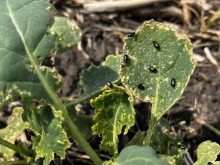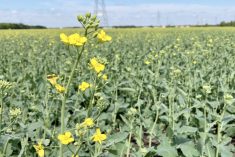(Resource News International) — Weather conditions in Alberta have helped speed up development of various
crops, but crop growth remains about a week behind average,
according to a provincial crop specialist.
“Crops were easily seven to 10 days behind in development, but
some improvement in the weather has allowed crops to only be
about five to seven days behind in growth,” said Neil Whatley, a crop
specialist with the Alberta Ag-Info Centre in Stettler, on Tuesday.
In terms of soil moisture, there was concern about the dry
Read Also

Entomologist tests trap crops and marigolds to repel flea beetles at an Ag in Motion
An Agriculture Canada entomologist is experimenting with trap crops and marigolds at an Ag in Motion demonstration cropplot
areas are bordering on excessive moisture, he said. The central
areas of Alberta were said to have adequate topsoil moisture, but
inadequate subsoil moisture reserves.
The driest areas of Alberta included those northeast and northwest of Edmonton, Whatley said. “There had
been some great spring precipitation in those areas, but little
moisture has occurred in those regions since,” he said.
The western and southern areas of the Peace River region of
northern Alberta were also considered very dry to the point,
where it’s “pretty bad for some crops,” Whatley said.
In southern areas of the province, Whatley said soil
moisture levels are very good, but frequent hail storms have
damaged crops.
Damage assessment to the crops from hail storms
was still ongoing, he said.
Most canola crops in Alberta were said to be in the
flowering stage of development, although there were a few
isolated fields where podding has begun, Whatley said. Winter
wheat fields were beginning to turn colour in a number of areas
with some spring wheat crops also nearing that stage of
development.
Whatley said wheat midge has become a problem in the
province with producers actively spraying in an effort to control
the spread of the damage.
Some of the wheat fields in the province were also at the
point of maturity where spraying for wheat midge would be
ineffective, Whatley said.


















